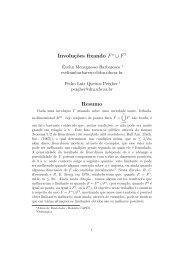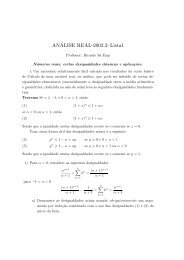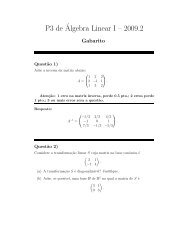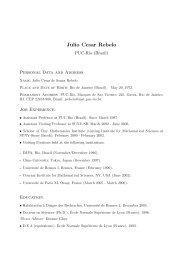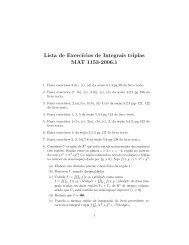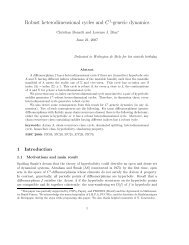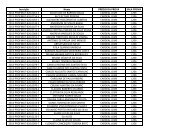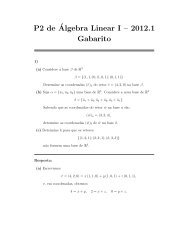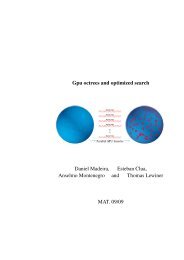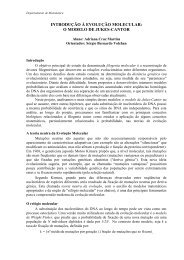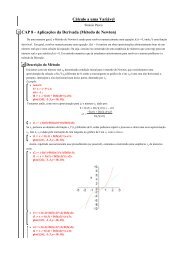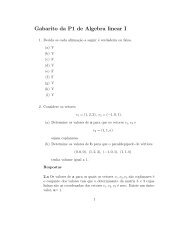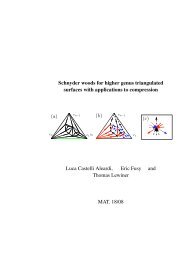NORMAL SUBGROUPS OF DIFFEOMORPHISM AND ...
NORMAL SUBGROUPS OF DIFFEOMORPHISM AND ...
NORMAL SUBGROUPS OF DIFFEOMORPHISM AND ...
Create successful ePaper yourself
Turn your PDF publications into a flip-book with our unique Google optimized e-Paper software.
here as Theorem ??. I also prove some new results for any open manifold M.<br />
All the results are valid for diffeomorphism groups of class C r , r = 1, 2, . . . , ∞<br />
and also for homeomorphism groups (r = 0), except that r ≠ dim(M) + 1 in<br />
Theorem ?? since we use Mather’s theorem. I would like to thank Tomasz<br />
Rybicki for encouraging me to publish this paper after all these years.<br />
2 Definitions and Results<br />
We recall some definitions from McDuff’s paper [?]. Let M be a connected<br />
n-manifold. For r = 1, 2, . . . , ∞, we set A = A(M) = Diff r (M), the group<br />
of all C r diffeomorphisms of M with the C r compact-open topology, and for<br />
r = 0 we let A = Homeo(M) be the group of homeomorphisms of M. Let A 0<br />
be the identity component of A, so that it consists of the diffeomorphisms<br />
that are C r isotopic to the identity map I (or the homeomorphisms that are<br />
topologically isotopic to I, if r = 0). The support supp(g) of a diffeomorphism<br />
g ∈ A is the closure of the set {x ∈ M | g(x) ≠ x} and the support of an<br />
isotopy {g t | t ∈ [0, 1]} with g 0 = I is the closure of the union of the supports<br />
∪ t∈[0,1] supp(g t ). All manifolds are connected.<br />
Theorem 2.1 Let h ∈ A 0 be a diffeomorphism isotopic to the identity map<br />
of an open (i.e., non-compact) manifold M such that supp(h) is not compact,<br />
and let H be any normal subgroup of A 0 containing h. Then the subgroup A I<br />
of A 0 consisting of all diffeomorphisms that are isotopic to the identity map<br />
of M by isotopies with compact support is contained in H.<br />
In the case that the manifold M is R n , we have the following stronger<br />
version of Theorem ??, using the same notation.<br />
Theorem 2.2 Let A = Diff r (R n ) be the group of all C r diffeomorphisms of<br />
R n , 0 ≤ r ≤ ∞. Then the subgroup of orientation preserving diffeomorphisms<br />
A + , which coincides with the subgroup A 0 of diffeomorphisms isotopic to I,<br />
and the groups κ −1 (η) where r ≥ 1 and η varies over all the subgroups of<br />
π 0 Diff r +(S n ) (or, equivalently, of θ n+1 , if n ≠ 4) are normal subgroups of A +<br />
and (except possibly if n = 4) also of A. If r ≠ n + 1, these are the only<br />
non-trivial normal subgroups of A 0 = A + and of A. For r = 0, the only<br />
proper normal subgroups of A 0 and A are A K = A I and A 0 .<br />
3



